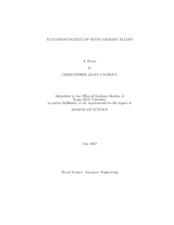| dc.contributor.advisor | Lagoudas, Dimitris | |
| dc.creator | Calhoun, Christopher | |
| dc.date.accessioned | 2012-07-16T15:57:41Z | |
| dc.date.accessioned | 2012-07-16T20:23:01Z | |
| dc.date.available | 2014-09-16T07:28:18Z | |
| dc.date.created | 2012-05 | |
| dc.date.issued | 2012-07-16 | |
| dc.date.submitted | May 2012 | |
| dc.identifier.uri | https://hdl.handle.net/1969.1/ETD-TAMU-2012-05-10773 | |
| dc.description.abstract | A testing method was developed to cycle quickly and repeatably Ni60Ti40 (wt. %) SMA specimens through temperature-induced transformation while under constant stress until failure. Previous works have shown fatigue cracks to initiate in or around Ni3Ti precipitates during repeated thermal cycling in this highly Ni-rich alloy. Actuation fatigue tests were conducted on specimens produced from material from different material suppliers and direction relative to cold-rolling. The specimens were placed under a constant applied stress of 200 MPa and thermally cycled through complete transformation. Some of the specimens were homogenized for 1 hour in a vacuum furnace and the rest were homogenized for 2 hours in a nitrogen furnace, and were all aged for 20 hours.
It was seen during actuation fatigue testing that specimens homogenized for two hours had higher actuation strain, accumulated more irrecoverable strain and had longer actuation fatigue lives compared to specimens homogenized for one hour. Another trend observed was that specimens with the greatest amount of accumulated irrecoverable strain, which was caused predominately by transformation induced plasticity, had the longest actuation fatigue lives. Postmortem analysis showed a change in cracking behavior with precipitate orientation. Cracks initiated inside the Ni3Ti precipitates oriented parallel to the loading direction and at the interface between the precipitate and matrix when perpendicular. Two dimensional plane stress finite element simulations of a linear elastic ellipsoidal precipitate inside a non-linear transforming SMA matrix were conducted to explain further the change in cracking behavior by analyzing the stress fields in and around the precipitates. The results showed the stress inside the precipitate was greater when oriented parallel than perpendicular to the loading direction, which explains the observed change in cracking behavior.
Another objective of actuation fatigue testing is to generate useful data to create predictive tools for future SMA actuator designs. A work-based method has been
developed using actuation fatigue results found in literature. The method is shown to fit accurately data found in literature to a curve with only two material parameters. The results of this method show promise to predict accurately the actuation fatigue life of SMA components, however more testing is necessary to validate completely the method. | en |
| dc.format.mimetype | application/pdf | |
| dc.language.iso | en_US | |
| dc.subject | Actuation fatigue | en |
| dc.subject | Transformation-induced fatigue | en |
| dc.subject | Ni-rich NiTi | en |
| dc.subject | Work-based method | en |
| dc.title | Actuation Fatigue of Shape Memory Alloys | en |
| dc.type | Thesis | en |
| thesis.degree.department | Aerospace Engineering | en |
| thesis.degree.discipline | Aerospace Engineering | en |
| thesis.degree.grantor | Texas A&M University | en |
| thesis.degree.name | Master of Science | en |
| thesis.degree.level | Masters | en |
| dc.contributor.committeeMember | Fry, Gary | |
| dc.contributor.committeeMember | Kinra, Vikram | |
| dc.type.genre | thesis | en |
| dc.type.material | text | en |
| local.embargo.terms | 2014-07-16 | |


